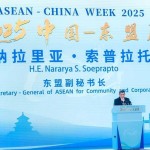Total number of posts 463.

As countries in the Indo-Pacific region continue to respond to Covid-19, the EU-ASEAN strategic partnership strives to ensure supply chain resilience for essential commodities. , including food, personal protective equipment, and vaccines, through commercial linkages and vaccine multilateralism.
The EU and ASEAN are the two most outward-looking trade blocs. Both benefit from globalization and integration into the global economy. Anti-globalization trends began to emerge after the 2008 global financial crisis with the rise of populist parties, exacerbated by the Covid-19 pandemic.
How can the EU and ASEAN show that instead of looking inward, economic diversification and greater connectivity and connectivity will help build resilience? As a result, the EU and ASEAN restarted inter-regional negotiations on an ASEAN-EU free trade agreement.
A few years ago, after the EU successfully signed bilateral FTAs with Singapore and Vietnam, there was real interest in reviving the EU-ASEAN inter-regional FTA. The majority of respondents in the 2021 Southeast Asia level survey believe that an ASEAN-EU FTA will help expand ASEAN's strategic space.
However, many people are also aware that problems are obstacles. With the coup in Myanmar, this becomes even more difficult. ASEAN quickly responded with a statement calling for a return to normalcy in accordance with the will and interests of the people of Myanmar. As the violence continued with no solution in sight, ASEAN convened a summit and reached a five-point consensus, calling for an immediate end to the violence in Myanmar and encouraging constructive dialogue. between the parties concerned to find a peaceful solution for the benefit of the people. The five-point consensus also includes a Special Envoy of the ASEAN Chair to visit Myanmar, meet with all stakeholders and facilitate mediation of the dialogue process by the various groups with the assistance of the Secretary-General of ASEAN.
To deal with such a complex issue with no easy solution, it is important to draw lessons from the past to not let Myanmar become a millstone in EU-ASEAN relations. Instead, what is needed at this time is regular consultation and dialogue between the two strategic partners to find common ground to support measures that can reduce losses.
In the spirit of not letting a single member state influence the broader EU-ASEAN agenda, the EU needs to revive dialogue towards an EU-ASEAN FTA (with Myanmar joining only when key conditions are met). appropriate value) and restart negotiations toward an FTA. If it is difficult to achieve a comprehensive, high-quality FTA at this stage, priority could be placed on concluding a specialized agreement on digital trade and e-commerce with a growth rate of exponential and huge potential in these areas.
The EU-ASEAN strategic partnership comes at a time of great uncertainty due to the rivalry between the US and China, against globalization and technological disruption, all exacerbated by the Covid-19 pandemic. It is important that the EU and ASEAN do not let the Sino-American rivalry affect the relationship. The EU has the opportunity to become an independent “pole” by seeking to proactively work with other like-minded partners in the Indo-Pacific and place an emphasis on a strategic partnership with ASEAN.
ASEAN countries are also not immune to the pull of strategic forces from outside the region. With the proliferation of competitive Indo-Pacific strategies advocated by major powers, ASEAN faces the challenge of maintaining its centrality among all these forces. The EU can play an important role in supporting ASEAN centrality and working together with other middle powers to shape the regional and global agenda.
More importantly, they must work collaboratively to deliver an alternative vision of a more open and networked system with a complex order that can accommodate the diversity and disparity of the world population of nearly 8 billion people.
Source: Công Thương News














